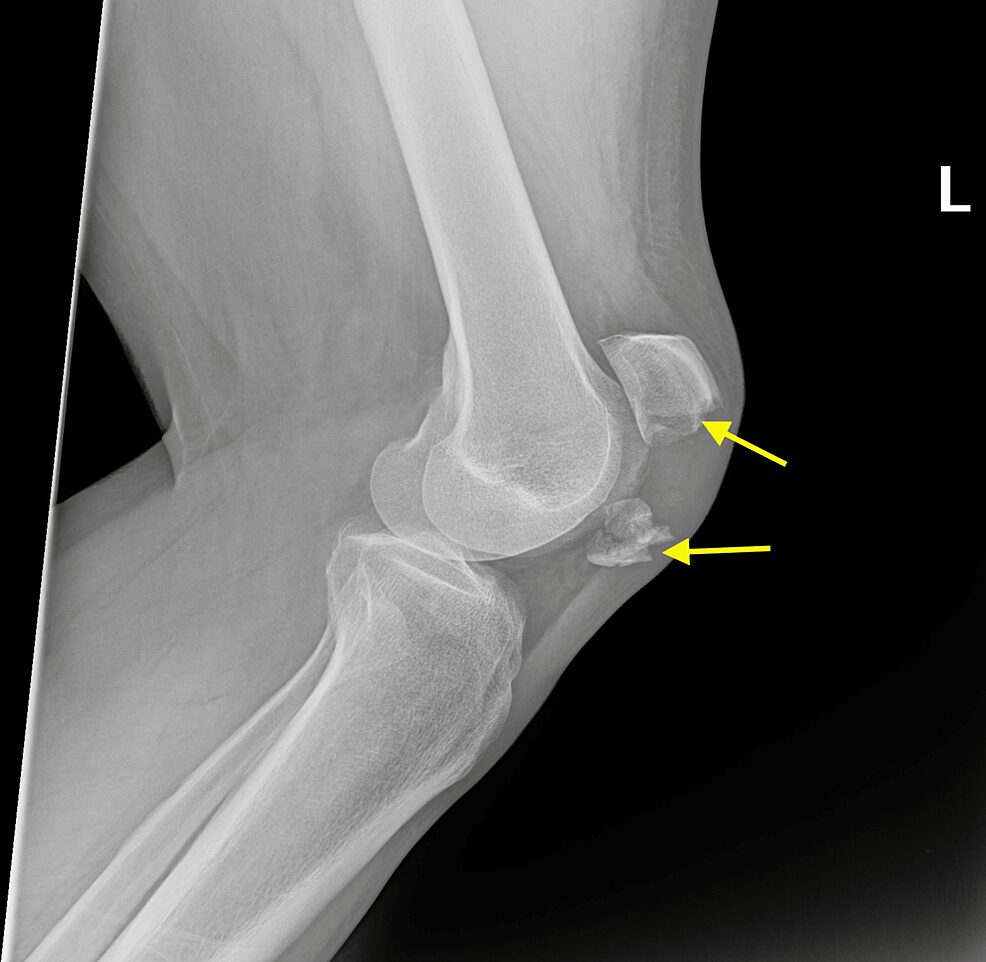What are the symptoms of a patella fracture?
The symptoms of a patella fracture (kneecap fracture) can vary depending on the severity of the fracture, but common signs include:
- Knee Pain:
- Intense pain in the front of the knee, especially when moving the knee or applying weight to the leg.
- Swelling:
- Swelling around the knee joint, which can develop rapidly after the injury.
- Bruising:
- Discoloration (bruising) around the kneecap and surrounding area.
- Deformity:
- Visible deformity of the kneecap, which may appear out of place or misaligned.
- Limited Range of Motion:
- Difficulty bending or straightening the knee fully.
- Tenderness:
- Increased sensitivity and tenderness when touching the kneecap.
- Instability:
- A feeling of instability in the knee, particularly when attempting to walk or bear weight.
- Popping or Cracking Sound:
- A popping or cracking sound may be heard at the time of injury.
Conclusion
If a patella fracture is suspected, it is essential to seek medical attention promptly for an accurate diagnosis and appropriate treatment.
What are the causes of a patella fracture?
A patella fracture can occur due to various factors, including:
- Direct Trauma:
- A fall onto the knee or a direct blow to the kneecap, such as from a collision during sports or an accident, can lead to a fracture.
- Indirect Trauma:
- Forceful contraction of the quadriceps muscle, such as during a jump or sudden stop, can cause the patella to fracture. This is more common in athletes.
- High-Impact Activities:
- Sports that involve jumping, running, or quick direction changes (e.g., football, basketball, gymnastics) increase the risk of patellar fractures.
- Osteoporosis:
- Weakened bones due to conditions like osteoporosis can make the patella more susceptible to fractures from minor injuries or falls.
- Repetitive Stress:
- Overuse or repetitive stress on the knee joint from certain activities can lead to stress fractures in the patella.
- Age-Related Factors:
- Older adults may have an increased risk due to age-related bone density loss and falls.
- Previous Injuries:
- Individuals with a history of knee injuries or previous patella fractures may be at higher risk for future fractures.
Conclusion
Understanding the causes of patella fractures can help in prevention and awareness, particularly for those engaged in high-risk activities or individuals with predisposing conditions. If a patella fracture is suspected, it is essential to seek prompt medical evaluation and care.
How is the diagnosis of a patella fracture made?
The diagnosis of a patella fracture typically involves several steps to ensure an accurate assessment. These may include:
- Medical History:
- The doctor will ask about the injury, including how it occurred, the nature of the pain, and any prior knee injuries.
- Physical Examination:
- A thorough examination of the knee is performed to assess swelling, bruising, tenderness, and any deformity of the patella. The doctor may check the range of motion and stability of the knee.
- Imaging Studies:
- X-rays:
- The primary imaging method for diagnosing a patella fracture. X-rays can reveal the presence and type of fracture, including any displacement or misalignment of the patella.
- CT Scan or MRI:
- In some cases, especially if the fracture is complex or if there is concern about associated injuries to the surrounding structures, a CT scan or MRI may be ordered for more detailed imaging.
Conclusion
Accurate diagnosis of a patella fracture is essential for determining the appropriate treatment plan. If you suspect a patella fracture, seeking medical attention promptly is crucial.
What is the treatment or a patella fracture?
The treatment for a patella fracture depends on the type and severity of the fracture, as well as the patient’s overall health and activity level. Common treatment options include:
- Non-Surgical Treatment:
- Rest and Immobilization:
- The knee is typically immobilized using a brace or a splint to prevent movement and allow healing.
- Crutches:
- Patients are often advised to use crutches to avoid putting weight on the affected leg.
- Ice Therapy:
- Applying ice to the knee can help reduce swelling and pain.
- Elevation:
- Keeping the leg elevated can also aid in reducing swelling.
- Pain Management:
- Over-the-counter pain relievers, such as ibuprofen or acetaminophen, may be recommended to manage pain.
- Surgical Treatment:
- Open Reduction and Internal Fixation (ORIF):
- For displaced fractures or fractures that cannot heal properly with conservative treatment, surgery may be required to realign and stabilize the bone using screws, plates, or wires.
- Partial or Total Patellectomy:
- In rare cases where the patella is severely damaged, partial or complete removal of the patella may be necessary.
- Rehabilitation:
- Physical Therapy:
- Once the fracture has stabilized, physical therapy may be recommended to improve strength, flexibility, and range of motion. This can help the patient return to normal activities.
- Gradual Weight-Bearing:
- As healing progresses, patients may gradually start to bear weight on the affected leg under the guidance of their healthcare provider.
Conclusion
The specific treatment plan for a patella fracture should be tailored to the individual and may require ongoing evaluation by a healthcare professional to ensure proper healing and recovery.

Leave a Reply
You must be logged in to post a comment.